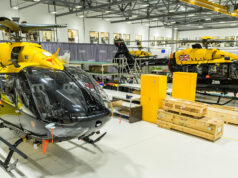Japanese media has reported that Japan has decided that it will develop the engine for the F-X fighter with help from Britain.
Rolls-Royce will partner with Japan’s IHI Corporation and both will also offer the engine for the export market.
According to Asahi here.
“Anonymous Japanese officials told the news outlet that Japanese Prime Minister Suga spoke on the issue with British Prime Minister Johnson during the G7 summit last month.
At the end of June, officials from Japan’s Defense Ministry traveled to Britain for talks on the issue. Britain’s Rolls Royce is currently involved in the Tempest program as well.”
The report adds:
“According to several Japanese government officials, an exchange on joint engine development was held at a meeting between Prime Ministers Yoshihide Suga and Johnson at the G7 Summit held in the United Kingdom in June.”
What is the F-X?
The Mitsubishi F-X is a sixth-generation stealth fighter in development for Japan and is Japan’s first domestically developed stealth fighter jet.
Japan expects production of the first fighter prototype to begin in 2024, with flight tests starting in 2028. Full-scale production is expected to commence by 2031.














If a common engine can be used for both the Tempest and the F-X it would certainly help with costs and viability of both programmes. Would work even if the two engines were similar and shared some/most parts in common.
Agree Rob. Parts as you say and I’m assuming significant R&D cost share even if they each end up selecting different concepts. Good news.
Japan knows how to pull their finger out, GB looking silly if they cannot match this sort of plan and build period!
I’m not sure that Rolls Royce (or BAE etc) are really ‘British’, these companies are now multinational institutions. Shareholders will have more sway than the UK government.
Just my cynical take on it of course.
The UK goverent still had that golden share rule. Where the share holders are based is irrelevant if the technology to designed developed and manufactured in the UK and Japan. It is excellent news as it adds credibility to both programs. I’m sure they will link up on some other sensors as well as it is far to expensive to develop everything themselves and if they bring in the US they will get screwed on exports.
I was sort of half joking, half serious mate, yes, the government (or governments in this case) will have a say in who they can sell to etc but these companies are there to make money first and foremost. I’m not saying they’re unpatriotic or whatever but ya know, it all goes back to that making money thing. These companies are huge and are based all over the world too.
This is a complex issue agreed. But fact is Bae is effectively a split company independently run. The US side is deeply influenced by the US Govt for its business, shareholders influence is deeply shaped by that. Meanwhile the British based side is deeply reliant on the UK Govt for its high end projects be they entirely British or through international cooperation. As Bae is predominantly a defence company now that will be the prime influence in its affairs and exports and shareholders influence moulded accordingly to reflect that state of affairs. So taking that into consideration the major influence the shareholders have is acquisitions and would (as with Unilever, HSBC, RD Shell in recent times) be to vote upon any decision by the board to relocate its headquarters.
RR is a bit different as it has a big non defence business too but I would say as history showed when it was bailed out, it’s Govt business is vital to its success and no doubt helps to allow it to remain competitive in the commercial field which remember is also part supported by Govt investment to finance serious new engine projects. It’s US side is also, be it Allison or other constituent parts has vital Govt sponsored military orientated business that probably would not be viable for the most part without. It’s German assets are somewhat less military orientated I suspect on balance but still it’s an important element as our and other Navies knows well.
So shareholders whatever their nominal power on paper, directly or indirectly are far less influential in these companies than most and any major changes would be reliant on Govt approval. Now if Bae Board decided it wanted to move headquarters to the US that would be the stark expression of where true power lies but the big decision making behind that would still be the board and Govt. The former no doubt likes using that as a bargaining chip in projects like Tempest and would not want to lose that influence while it still has major projects here providing good profits, though that balance may well further change in the future making it an easier decision especially if Tempest were cancelled for example. But the shareholders rubber stamping such a move would absolutely as you say for the most part at least, be dominated by personal value to them and the international element of the shareholders is an important consideration in terms of loyalties
Hmme
Well if you look at various Defence Acts on the UK statute books all the IP is property of HMG – similar to the States.
Who owns the shares is immaterial.
As far as RR are concerned defence is the big money spinner ATM as civil aviation is in the doldrums and RR get paid on an hours flown basis.
It would certainly make sense to partner the engine development as it is a huge part of the cost.
I wouldn’t be so sure we won’t get a license of the sensor action as well: we have most of it home grown.
‘It would certainly make sense to partner the engine development as it is a huge part of the cost’
I agree. Development is staggeringly expensive and RR have been smart IMO in positioning R&D activities to gain funding from multiple sources. e.g. UK, EU (Germany), USA and Japan. It also helps with future sales to those markets.
RR have had some ups and downs lately, but they are in pretty good shape with their future tech roadmap. So ultimately UK benefits, having a world class domestic supplier, partly funded by others.
Both are listed on the LSE and headquartered in the UK. The UK government can also prevent them being sold.
BMW operate plants and facilities all over the world, they are still German.
That’s interesting a few of the previous replies have disappeared, took me ages to write mine too.
The comments that do not “suit” are deleted. One of mine was altered last week. Basically it is now a censored site and not worth bothering with. Many regulars have gone elsewhere.
Regulars? Who has left?
I have. 😅
If multiple people flag them I think they go into limbo until the comment is manually approved by George and his staff (at least that’s what I think happens) or there are issues server side because comments often vanish for a bit only to re-appear later.
*Bavarian.
Apart from BMW’s aero engine business, which funnily enough is owned by Rolls Royce!
It’s just how it works in aviation. Industrial offsets help export RR products. Japan makes sub assemblies for RR civil engines and as a consequence Japanese airlines buy engines from RR. This has been going on for years already.
Andy,
The BBC knocked out a program about the Rolls Royce (Engines) based in and around Derby. Most informative and well worth a butchers.
https://www.bbc.co.uk/programmes/b00t0yx9
Cheers mate, I think I watched it at the time. I generally try and catch stuff like this.
Not sure how you could extrapolate that from what I posted. Guess it says more about you really.
Its the same logic for any company and country, these big companies are almost countries themselves, its all getting a bit dystopian ‘MegaCorp’.
I seem to have triggered a few though with my slightly leftfield take on the subject.
Kind of a shame that we can’t combine FCAS/F-X/Tempest into a single, co-ordinated program.
And I don’t mean merge them all into a fighter necessarily, simply if we could co-ordinate design requirements for all three. Eg; F-X carrier borne variant for Izumo/CdG Replacement/QE’s, Tempest ground attack variant, FCAS air superiority variant (mix and match as required).
I think the Japanese would be quite difficult to work with. The UK is already working with Italy and Sweden. Defence projects don’t pan out well when there are too many cooks in the kitchen.
In an ideal world with unlimited resources Tempest would be 100% British developed.
Would be nice though I suspect as F35 has shown the difficulties out way the advantages if it’s too broad a programme. That said I reckon the above news has good vibes about further cooperation on these overall UK Japanese projects. To grab the Engine cooperation will be a big hit to US influence (the work on their 6th Gen engine sounds on paper impressive after all) and while joint aircraft design with the UK is probably a step too far for Japanese US relations to stomach it does show that Japan (esp after Trump) does not want to tied to the vagaries of US military/political machinations. Thus I reckon it bodes well on other aspects of the overall project with much mutual Input this will somewhat placate the US who will no doubt have their own input, while increasing Japanese and potentially even British dependence on the US. Meteor is a great example here. There would appear to be serious desire to do so and I think we are more inclined to accept technical transfer to make it happen which on a mutually beneficial basis could be an ideal outcome. Let’s hope this will indeed go wider it worries me that Bae and even RR are, post Brexit being pushed towards US cooperation as European equivalents are more excluded from them.
That’s why I’m thinking don’t merge them into a single program, more deconflict the aims of each program. Thinking for example more like Tornado/Eurofighter than F-35A/B/C. Don’t sit down and make a joint aircraft design (more than it is), but make sure FCAS and Tempest don’t fill exactly the same “niche” (I don’t know enough about J-X so I’m quietly dropping it here).
Politically that’s probably impossible to negotiate at the moment, but it would be ideal in terms of getting overall bang for our buck and leveling up European defence, rather than having two competing designs being produced in the same space.
*Edit* In my view there should baisically be three designs of fighter aircraft in Europe: A high end Air-Superiority fighter (Typhoon/Rafale), a Carrier capable Strike Aircraft (F-35/Tornado), and a low cost Interceptor (F-16/Gripen). So *ideally* any European fighter programs running concurrently should not be looking to fill the same slot. But I’m just an uninformed pongo.
As for the Brexit point, I think we’ve kind of made our bed and have to lie on it, I’ve always been mildly convinced that leaving or remain just means choosing between being dominated by the US or the EU.
Problem with this scenario is that because the F-35 is being produced in such huge quantities it is cheaper tha the “low cost” Grippen, as the Swiss purchase shows.
Never said it wasn’t, in fact wasn’t even saying that the Gripen should continue to fill that niche. Was saying that if more than one European fighter program is running it should make sure it’s not aiming for the same one of those three niches that any other european fighter program is aiming for, precisely so that they can be manufactured in greater numbers, bringing costs down.
(Also I wouldn’t class Switerzland as a European client that traditionally goes for the low end “cheap and cheerful fighter” option, they’re usually in for the F-35/Tornado all singing all dancing group anyway).
No it doesn’t. Grippen wasn’t in the Swiss competition.
Think with the US it’s easier because the EU your dealing with several nations which put in service dates back by not agreeing on the spc of the platform or pulling out of the project altogether.
Britains done its fair share of this, pulling out of project developments only to then still buy the finished product now without industrial workshare.
Seems like a good argument for a Common European Defence Policy now that the UK isn’t in the EU to veto it.
Even the USN and USAF have learned their lessons from the JSF program. They are each separately developing their own 6th gen fighters. I doubt there will ever be another “joint” fighter program in America again.
I mean I’ve pointed out multiple times that I’m not advocating a joint fighter program. Please do me the favour of reading my posts where I explain.
Not sure that would be workable except at a very basic level. Peripherals such as radars, weapons systems, software possibly. Probably the powerplant could have a lot of ‘similarities’. However look at the issues trying to get 3 variants of the F-35 together – and that’s the same company, not 3 separate entities. The actual airframes may be able to produced so they are superficially similar – but you are looking at major variations in performance/specification – one optimised for light weight/short takeoff ability, one requiring speed and possibly a high ceiling, one optimised for low level work.
…again as my previous reply: Please look at the entire thread? I’m not advocating a single airframe for three seperate purposes.
I did – I think Quora sometimes doesn’t really put things in the right place? – I was specifically answering ‘Kind of a shame that we can’t combine FCAS/F-X/Tempest into a single, co-ordinated program.
And I don’t mean merge them all into a fighter necessarily, simply if we could co-ordinate design requirements for all three. Eg; F-X carrier borne variant for Izumo/CdG Replacement/QE’s, Tempest ground attack variant, FCAS air superiority variant (mix and match as required).’
Specifically the ‘simply if we could co-ordinate design requirements for all three. Eg; F-X carrier borne variant for Izumo/CdG Replacement/QE’s, Tempest ground attack variant, FCAS air superiority variant (mix and match as required).’bit – in other words, don’t think we can co-ordinate the desiogn requirements for all three as per my answer.
Annnd if you’d have read my reply to Spyinthesky you’d have your answer.
Not really.
Then I suggest actually reading it.
I suggest likewise – you seem very uncertain about what you do mean. Your idea of coordination appears to mean… nothing. Just, don’t make the same as each other. Anyway, as we’re not getting anywhere I suggest there is little point continuing the conversation.
Not my fault you are having difficulty with simple English:
Co-ordination does not mean “Make sure all the airframes are simliar/use similar components.” It can mean a variety of things.
In this case, as I clearly pointed out, it means “Please can we make sure we don’t have multiple 6th generation jets competing for the exact same space in a very small market.”
The pivot to Asia and Brexit is already paying off: CPTPP and later a projected CANZUK will enable the CANZUK nations to compete seriously in aerospace with the US, China, Russia and the ESA+EU. Together we have the potential science, technology, wherewithal and the right stuff to succeed. All we have to do is to inject some ambition and backbone into our dismal and enervated political class.
It’s always a bad idea to talk about politics but why wouldn’t this have happened if we were still in the EU?
Trade deals obviously wouldn’t but a lot could have happened before now.
All trade deals involve trade-offs. Some sectors/countries are happy others not so much. The trick is to keep everyone happy enough not to throw it out. It’s a lot easier with just one country/Parliament than thirty plus all of whom have a veto.
Like the way Truss has abandoned the already struggling hill farmers in return for a trade deal worth 0.02% of GDP after 15 years?
If you run a business that can’t possibly cover it’s costs……..
Its not worth 0.02% after 15 years though is it?
The trade deal reduces tariffs on British exports to Australia by just £34m per year on £5.4bn of trade. In 15 years time the economic boost is equivalent to 0.02% of GDP growth.
In return Britain drops tariffs on Australian sheep meat completely, creates a duty free quota of 7,200 tonnes of butter and a beef quota that will rise each year up to 110,000 tonnes after 10 years.
Power and who shall wield it: everything else is froth.
But why couldn’t wouldn’t this deal happen exactly? France doesn’t seem to have issues selling it’s equipment all over the world
Join RUSI.
Exporting equipment to other countries and doing a trade deal that goes both ways are very very different things.
Because the EU has its own policies and requirements which may suit some nations in it but not others.
The EU does naturally do trade deals especially in times of need, see the China deal they did despite the terrible things going on in China but they needed it at the time of the UK leaving, so they can do quick deals when in times of need but in general they take a very long time to agree on things.
This is brilliant news. Lets hope the engines work for Tempest too. The consortium for producing none US 6th Gen jets is growing quickly. The Japanese engineering production capability is exceptional. Personally I’d like to see India, Australia/New Zealand, Israel, Taiwan and Singapore involved somehow.
New Zealand ?
I know they have a very much reduced NZRAF and little bottle for fighting these days. (Leftist limp soy’s in government.) But I didn’t want to miss them out and offend the ANZACS. The CCP will not miss them out.
Suggest you drop India & Taiwan from the list. Taiwan only want it if it’s cheap or free. Indian military procurement system is the only one in the world that makes Canada look good.
I hear you DJ but India has the all important land border with the CCP occupied China. While Taiwan has the legitimate Chinese government in exile. Both are important in the Cold War with the CCP.
Democracy despite all it’s benefits is far from perfect and India is the worlds largest. Little wonder they can never come to a unanimous decision. Kudos to them for sticking with it.
With such a huge armed force and potential market, with enemies on all sides. Giving them a hand is the right thing to do. What say you cousin?
Great in principle but they do have very good relations on the military front with Russia and you dont want too much equipment being inspected by them.
Good news, possibly a joint development for the engine for the F-X Tempest programs. I think it could give the UK a head start over the European program. I wonder if the pre-cooler from Reaction engines could be used on the Tempest engine.
Not just the precooler why not the whole engine. Mach 5 to anywhere on the planet 😉. They could even rename it Talon. When reaction engines finally get the sabre to work it’s going to be a big step up for aviation.
An old relationship restored after the falling out in WW2 . understand one of the new RN carriers will be based there . 😄
Why? UK only has two. A fair part of the time, only one would be operational. Basing the one operational one half a world away when USN already has one based there & both Japan & S.Korea are building their own makes no sense.
Japan looks to being more independent from American sales, more in charge of what plane it flys and what equipment and defences it has. Countries and regions with the CCP threat hanging over them are beginning too realise alliiences, are a strength especially if they have a trusted trading partner. There is a lot to be gained in these relationships. Neither is restrained by the alliiences and able to seek the outcomes it needs. This is good news.
Time to scrap Tempest and buy this instead. Because it will work out of the box, cost less and we can have more of them. “Ducks and Covers” ahead of the Buy British Lobby 😉
I don’t agree with scrapping Tempest but if Japan is seriously considering export sales, then a BAE link-up might be a possibility with a UK assembly line.
I have to say I’m a massive fan of a return to genuinely closer military ties with Japan, which until the 1920s had been the norm. And post Brexit I’m really keen to link up more with our Commonwealth partners, particularly Australia, New Zealand, and Canada.
Since india is also planningto develop a engine for thr fifth gen fighter Britian Japan , India can join with equal share to develop , produce test and then commercially produce engines in their respective countries. To bring down on costs design , testing facilties in india be developed and then production of over two thousand engines produced in india at a cheaper cost as labour eng costs are low .
After seeing the Indigenous engine they produced for the Tejas Mk1 (which wasnt even powerful enough for the aircraft to clear the tops of mountains and the head of the IAF said the aircraft worse than useless), and the failure to produce a higher thrust version for the AMCA, India is firmly in the buy off the shelf US engines trajectory using GE engines for the Tejas Mk2 and AMCA. As to the Kaveri engine development, last I heard the program had pivoted from developing its own engine into producing the French Snecma M88 under license (which has powered the Rafale since 1990).
We need to diversify joint research and production away from the EU. While deals with USA are still paramount, we will always be the junior partner in these, so it makes sense to do more deals with a massive High-tech country like Japan. We have similar interests in matters of defense.